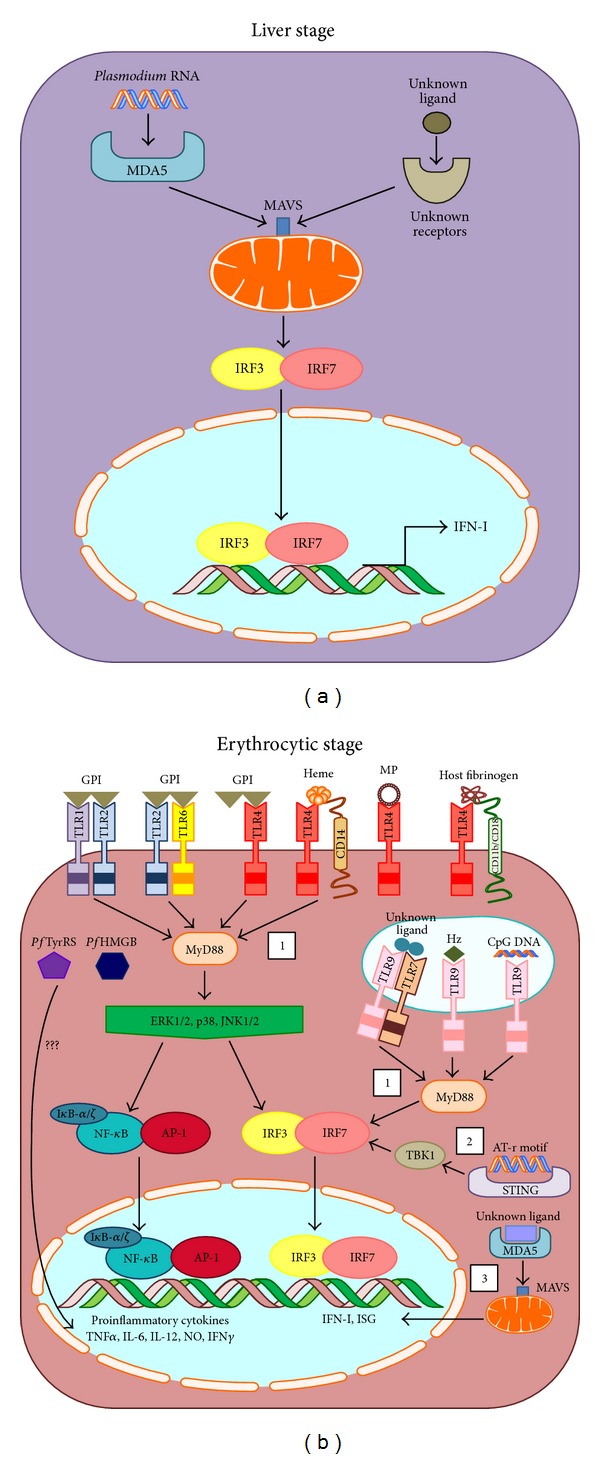Figure 1.

(a) Signaling pathway induced by malarial ligand during liver-stage infection. Plasmodium RNA is recognized by MDA5 (melanoma differentiation-association protein 5) present in the cytoplasm. Ligand-receptor interaction triggers assembly of MAVS (mitochondrial antiviral signaling protein) that aggregate on the surface of mitochondria. This eventually leads to the activation of both IRF-3 and IRF-7 which regulate transcription of IFN-I. Besides MDA5, activation of other receptors can also trigger aggregation of MAVS. However, this specific receptor and its corresponding malarial ligand have yet to be identified. (b) Signaling pathway induced by malarial ligand during erythrocytic-stage infection. Surface TLR4 recognizes a number of malarial ligands such as GPI (glycosylphosphatidylinositol membrane anchor) and MP (microparticles). Together with CD14 or CD11b/CD18 integrin, it can recognize heme and host fibrinogen, respectively. Both TLR heterodimer TLR1/TLR2 and TLR2/TLR6 recognize GPI. Within the endosomal compartment, Hz (Hemozoin) and CpG DNA are recognized by TLR9. In addition, TLR7/TLR9 heterodimer has been proposed to recognize an unknown malarial ligand. These ligand-receptor interactions trigger 3 proposed pathways. (1) TLR-dependent pathway involves the recruitment of MyD88 (myeloid differentiation primary gene 88) to TLR, which phosphorylates downstream MAPKs (mitogen-activating protein kinases), such as ERK1/2 (extracellular-signal-regulated kinases 1/2), p38 MAPK, and JNK1/2 (c-Jun N-terminal kinases 1/2). Subsequently, NF-κB (nuclear factor kappa-light-chain-enhancer of activated B cells) and AP-1 (activating protein-1) translocate into the nucleus and stimulate production of proinflammatory cytokines. At the same time, phosphorylated MAPKs or MyD88 can induce activation of IRF-3 and IRF-7 to transcribe IFN-I and ISGs (interferon stimulated genes). (2) Activation of TLR-independent pathway triggered by AT-rich motif present in the plasmodial genome engages STING, TBK, IRF-3, and IRF-7. (3) Another TLR-independent pathway involves MDA5 and MAVS. PfTyrRS (P. falciparum tyrosyl-tRNA synthetase) and PfHMGB (P. falciparum high mobility group box protein) were shown to induce proinflammatory responses but the exact signaling pathways have yet to be identified.
